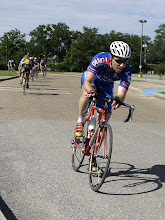I met that guy
Not exactly the guy you want to meet when riding in a group setting. Luckily, he didn't take me or anyone down during the ride.
I wish I had video of the guy you want to avoid. Beautiful bike, great kit yet, he couldn't ride a bike in a straight line for more than one turn of the pedals. This is dangerous to those of you who do ride in a straight line.
Here's what you can do next time you start off in a group ride. If you are riding with the same group everyday, you know who to watch out for. If its a new town and a new group, it's time to do a quick assessment. Its all about observation of other riders movement patterns during the ride. Try to make your assessment early. If someone demonstrates poor riding skills early in the ride, you can count on the fact that they will only get worse as the ride progresses.
Take time to observe the line that each cyclist is riding. Also, look for riders who are demonstrating excessive motion that doesn't seem to be part of pedaling the bike forward. All of this excessive movement challenges the center of gravity of the bike and moves the center of gravity outside of the base of support. The base of support for a bicycle is the sum of two patches of rubber on the road. If you drop a plumb bob down from the center of mass of the rider/bike, it has to fall between the two patches of rubber. If the center of mass falls to the side, one of two things will happen. The bike will fall over or the bike must change direction to place the center of mass between the tire patches again. If the rider is constantly chasing the center of mass, the bike is constantly changing direction. This is crazy dangerous.
Rule #1: Stay away from them!!!, give them at least one wheel length. Getting too close will cost you.
Rule #2: Don't worry about them being part of the competition. Cycling is a sport of efficiency and economy in addition to power and endurance. Because cycling is such a high repetition sport, it doesn't take much loss of efficiency on each pedal stroke to cost a rider in the end.
Unfortunately, the average cyclist enthusiast doesn't get the training they need to make valuable changes in technique. This guy could be a totally different cyclist in just a matter of a couple months. I mean, completely different in a good way!

